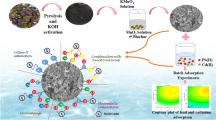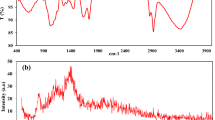Abstract
The potential of a granular activated carbon (GAC), a rice husk biochar (BRH), and multi-walled carbon nanotubes (MWCNTs) for removing 2,4-dichlorophenoxyacetic acid (2,4-D) from simulated wastewater and drainage water has been evaluated. In this regard, a response surface methodology (RSM) with a central composite design (CCD) (CCD-RSM design) was used to optimize the removal of 2,4-D from simulated wastewater under different operational parameters. The maximum adsorption capacities followed the order GAC > BRH > MWCNTs, whereas the equilibrium time increased in the order MWCNTs < GAC < BRH. In the case of GAC and BRH, the 2,4-D removal percentage increased significantly upon increasing the adsorbent dosage and temperature and decreased upon increasing the initial 2,4-D concentration and pH. The results showed that the contact time and temperature were not important as regards the adsorption efficiency of 2,4-D by MWCNTs, whereas rapid removal of 2,4-D from simulated wastewater was achieved within the first 5 min of contact with the MWCNTs. The results confirmed that the Freundlich isotherm model with the highest coefficient of determination (R2) and the lowest standard error of the estimate (SEE) satisfactorily fitted the 2,4-D experimental data. In addition, successful usage of the three adsorbents investigated was observed for removal of 2,4-D from drainage water from an agricultural drainage system. An economic analysis with a rate of return (ROR) method indicated that BRH could be used as an eco-friendly, low-cost, versatile, and high adsorption capacity alternative to GAC and MWCNTs for the removal of 2,4-D.












Similar content being viewed by others
References
Abigail M, Chidambaram R (2016) Rice husk as a low cost nanosorbent for 2,4-dichlorophenoxyaceticacid removal from aqueous solutions. Ecol Eng 92:97–105
Ahmad AL, Tan LS, Shukor SRA (2008) Dimethoate and atrazine retention from aqueous solution by nanofiltration membranes. J Hazard Mater 151:71–77
Ahmaruzzaman M, Gupta VK (2011) Rice husk and its ash as low-cost adsorbents in water and wastewater treatment. Ind Eng Chem Res 50:13589–13613
Aksu Z, Kabaskal E (2004) Batch adsorption of 2,4-dichlorophenoxy-acetic acid (2,4-D) from aqueous solution by granular activated carbon. Sep Purif Technol 35:223–240
Aksu Z, Kabaskal E (2005) Adsorption characteristics of 2,4-D from aqueous solution on powdered activated carbon. Sep Purif Technol 40:545–570
Al-Qodah Z, Shawabkah R (2009) Production and characterization of granular activated carbon from activated sludge. Braz J Chem Eng 26:127–136
Amiri MJ, Abedi-Koupai J, Eslamian S, Arshadi M (2016) Adsorption of Pb(II) and Hg(II) ions from aqueous single metal solutions by using surfactant-modified ostrich bone waste. Desalin Water Treat 57:16522–16539
Anisuzzaman S, Joseph C, Taufiq-Yap Y, Krishnaiah D, Tay V (2015) Modification of commercial activated carbon for the removal of 2,4-dichlorophenol from simulated wastewater. JKSUS 27:318–330
Arasteh R, Masoumi M, Rashidi AM, Moradi L, Samimi V, Mostafavi ST (2010) Adsorption of 2-nitrophenol by multi-wall carbon nanotubes from aqueous solutions. Appl Surf Sci 256:4447–4455
Arshadi M, Amiri MJ, Mousavi S (2014) Kinetic, equilibrium and thermodynamic investigations of Ni(II), Cd(II), Cu(II) and Co(II) adsorption on barley straw ash. Water Res Industry 6:1–17
Arshadi M, Mousavinia F, Amiri MJ, Faraji AR (2016) Adsorption of methyl orange and salicylic acid on a nano-transition metal composite: kinetics, thermodynamic and electrochemical studies. J Colloid Interface Sci 483:118–131
Bahrami M, Amiri MJ, Koochaki S (2017a) Removal of caffeine from aqueous solution using multi-wall carbon nanotubes: kinetic, isotherm, and thermodynamics studies. Pollution 3:539–552
Bahrami M, Amiri MJ, Mahmoudi MR, Koochaki S (2017b) Modeling caffeine adsorption by multi-walled carbon nanotubes using multiple polynomial regression with interaction effects. J Water Health 15:526–535
Bakouri HE, Morillo J, Usero J, Oussani A (2008) Potential use of organic waste substances as an ecological technique to reduce pesticide groundwater contamination. J Hydrol 353:335–342
Bazrafshan E, Kord Mostafapour F, Faridi H, Farzadkia M, Sargazi SH, Sohrabi A (2013) Removal of 2, 4-dichlorophenoxyacetic acid (2,4-D) from aqueous environments using single-walled carbon nanotubes. Health Scope 2:39–46
Boivin A, Amella S, Schiavon M, Van Genuchten MT (2005) 2,4-dichlorophenoxyacetic acid (2,4-D) sorption and degradation dynamics in three agricultural soils. Environ Pollut 138:92–99
Chen B, Chen Z, Lv S (2011) A novel magnetic biochar efficiently sorbs organic pollutants and phosphate. Bioresour Technol 102:716–723
Dehghani M, Nasseri S, Karamimanesh M (2014) Removal of 2,4-dichlorophenolyxacetic acid (2,4-D) herbicide in the aqueous phase using modified granular activated carbon. J Environ Health Sci Eng 12:28
Deokar SK, Mandavgane SA (2015) Rice husk ash for fast removal of 2,4-dichlorophenoxyacetic acid from aqueous solution. Adsorpt Sci Technol 33:429–440
Ding L, Lu X, Deng H, Zhang X (2012) Adsorptive removal of 2,4-dichlorophenoxyacetic acid (2,4-D) from aqueous solutions using MIEX resin. Ind Eng Chem Res 51:11226–11235
Ebrahimizadeh MA, Amiri MJ, Eslamian SS, Abedi-Koupai J, Khozaei M (2009) The effects of different water qualities and irrigation methods on soil chemical properties. Res J Environ Sci 3:497–503
Edvin Vasu A (2008) Surface modification of activated carbon for enhancement of nickel (II) adsorption. J Chem 5:814–819
Ehyaee M, Safa F, Shariati S (2017) Magnetic nanocomposite of multi-walled carbon nanotube as effective adsorbent for methyl violet removal from aqueous solutions: response surface modeling and kinetic study. Korean J Chem Eng 34:1051–1061
Hallin IL, Douglas P, Doerr SH, Bryant R, Charbonneau C (2017) The potential of biochar to remove hydrophobic compounds from model sandy soils. Geoderma 285:132–140
Hameed BH, Salman JM, Ahmad A (2009) Adsorption isotherm and kinetic modeling of 2,4-D pesticide on activated carbon derived from date stones. J Hazard Mater 163:121–126
Han D, Jia W, Liang H (2010) Selective removal of 2,4-dichlorophenoxyacetic acid from water by molecularly-imprinted amino-functionalized silica gel sorbent. J Environ Sci 22:237–241
Humbert H, Gallard H, Suty H, Croue JP (2008) Natural organic matter (NOM) and pesticides removal using a combination of ion exchange resin and powdered activated carbon (PAC). Water Res 42:1635–1643
Iannazzo D, Pistone A, Ziccarelli I, Espro C, Galvagno S, Giofré SV, Romeo R, Cicero N, Bua GD, Lanza G, Legnani L, Chiacchio MA (2017) Removal of heavy metal ions from wastewaters using dendrimer-functionalized multi-walled carbon nanotubes 24: 14735–14747
Imagawa A, Seto R, Nagaosa Y (2000) Adsorption of chlorinated hydrocarbons from air and aqueous solutions by carbonized rice husk. Carbon 38:623–641
Jung BK, Hasan Z, Jhung SH (2013) Adsorptive removal of 2,4-dichlorophenoxyacetic acid (2,4-D) from water with a metal-organic framework. Chem Eng J 234:99–105
Kearns JP, Wellborn LS, Summers RS, Knappe DRU (2014) 2,4-D adsorption to biochars: effect of preparation conditions on equilibrium adsorption capacity and comparison with commercial activated carbon literature data. Water Res 62:20–28
Lehman JH, Terrones M, Mansfield E, Hurst KE, Meunier V (2011) Evaluating the characteristics of multiwall carbon nanotubes. Carbon 49:2581–2602
Li X, Zhao H, Quan X, Chen S, Zhang Y, Yu H (2011) Adsorption of ionizable organic contaminants on multi-walled carbon nanotubes with different oxygen contents. J Hazard Mater 186:407–415
Li Q, Sun J, Ren T, Gue L, Yang Z, Yang Q, Chen H (2017) Adsorption mechanism of 2,4-dichlorophenoxyacetic acid onto nitric acid modified activated carbon fiber. Environ Technol 7:1–12
Liang L, Zhang J, Feng P, Li C, Huang Y, Dong B, Li L, Guan X (2015) Occurrence of bisphenol a in surface and drinking waters and its physicochemical removal technologies. Front Env Sci Eng 9:16–38
Mandal S, Sarkar B, Igalavithana AD, Ok YS, Yang X, Lombi E, Bolan N (2017) Mechanistic insights of 2,4-D sorption onto biochar: influence of feedstock materials and biochar properties. Bioresour Technol (246):160–167
Manna S, Saha P, Roy D, Sen R, Adhikari B (2016) Removal of 2,4-dichlorophenoxyacetic acid from aqueous medium using modified jute. J Taiwan Inst Chem Eng 67:292–299
Mohammad SG, Ahmed SM (2017) Preparation of environmentally friendly activated carbon for removal of pesticide from aqueous media. Int J Ind Chem 8:121–132
Mourabet M, El Rhilassi A, El Boujaady H, Bennani-Ziatni M, Taitai A (2017) Use of response surface methodology for optimization of fluoride adsorption in an aqueous solution by Brushite. Arab J Chem 10:S3292–S3302
Nethaji S, Sivasamy A (2017) Graphene oxide coated with porous iron oxide ribbons for 2, 4-dichlorophenoxyacetic acid (2,4-D) removal. Ecotoxicol Environ Saf 138:292–297
Qu X, Alvarez PJJ, Li Q (2013) Applications of nanotechnology in water and wastewater treatment. Water Res 47:3931–3946
Remer D, Nieto A (1995) A compendium and comparison of 25 project evaluation techniques, part 1: net present value and rate of return methods. Int J Prod Econ 42:79–96
de Rezende EIP, Peralta-Zamora PG, Abate G (2011) Sorption study of herbicides with the clay minerals vermiculite and montmorillonite. Quim Nova 34:21–27
Rostamian R, Heidarpour M, Mousavi SF, Afyuni M (2015) Preparation, characterization and sodium sorption capability of rice husk carbonaceous adsorbents. Fresenius Environ Bull 24:1649–1658
Salman JM, Njoku VO, Hameed BH (2011) Adsorption of pesticides from aqueous solution onto banana stalk activated carbon. Chem Eng J 174:41–48
Salmon JM, Hameed BH (2010) Adsorption of 2,4-dichlorophenoxyacetic acid and carbofuran pesticides onto granular activated carbon. Desalination 256:129–135
Santacruz G, Bandala ER, Torres LG (2005) Chlorinated pesticides (2,4-D and DDT) biodegradation at high concentrations using immobilized Pseudomonas fluorescens. J Environ Sci Health Heal B 40:571–583
Saritha P, Aparna C, Himabindu V, Anjaneyulu Y (2007) Comparison of various advanced oxidation processes for the degradation of 4-chloro-2 nitrophenol. J Hazard Mater 149:609–614
Shirmardi M, Alavi N, Babaei A (2016) Removal of atrazine as an organic micropollutant from aqueous solutions: a comparative study. Process Saf Environ Prot 103:23–35
Srivastava VC, Mall ID, Mishra IM (2006) Characterization of mesoporous rice husk ash (RHA) and adsorption kinetics of metal ions from aqueous solution onto RHA. J Hazard Mater 134:257–267
United States Environmental Protection Agency (2015) “Notification per PRN 98-10 –Minor Label Updates; Change of Primary Brand Name to Amine 4 2,4-D Weed Killer” Rep. No. EPA-34704-120, Washington, DC. Available at: https://www3.epa.gov/pesticides/chem_search/ppls/034704-00120-20151106.pdf
Wang Y, Liu R (2017) Comparison of characteristics of twenty-one types of biochar and their ability to remove multi-heavy metals and methylene blue in solution. Fuel Process Technol 160:55–63
Wang Y, Ma J, Zhu J, Ye N, Zhang X, Huang H (2016) Multi-walled carbon nanotubes with selected properties for dynamic filtration of pharmaceuticals and personal care products. Water Res 92:104–112
Zeng Z-W, Tian S-R, Liu Y-G, Tan X-F, Zeng G-M, Jiang L-H, Yin Z-H, Liu N, Liu S-B, Li J (2018) Comparative study of rice husk biochars for aqueous antibiotics removal. J Chem Technol Biotechnol 93:1075–1084
Acknowledgements
AG is grateful for the financial support from Santander Bank through the Research Intensification Program.
Author information
Authors and Affiliations
Corresponding author
Additional information
Responsible editor: Philippe Garrigues
Rights and permissions
About this article
Cite this article
Amiri, M.J., Bahrami, M., Beigzadeh, B. et al. A response surface methodology for optimization of 2,4-dichlorophenoxyacetic acid removal from synthetic and drainage water: a comparative study. Environ Sci Pollut Res 25, 34277–34293 (2018). https://doi.org/10.1007/s11356-018-3327-x
Received:
Accepted:
Published:
Issue Date:
DOI: https://doi.org/10.1007/s11356-018-3327-x




